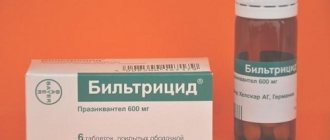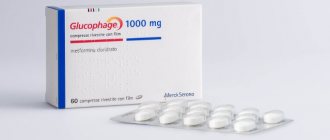Release forms and composition of the drug
Lindinet 20 is available in the form of round tablets, slightly convex at the edges, which are coated with a protective coating. The drug has a light yellow color. The tablets are packaged in blisters made of plastic and foil. Each cassette contains 21 tablets.
The main packaging of contraceptives is a cardboard box, inside of which there are 1 or 3 blisters with tablets. According to reviews from women who have used Lindinet 20, the formulation of the drug is convenient for daily use.
The table below details the constituent substances of the drug, and also describes their intended purpose in an oral contraceptive:
| Active and excipients Lindinet 20 | Pharmacological properties of chemical components |
| Ethinyl estradiol | This is the active substance of the drug Lindinet 20, which is a synthetic analogue of the female sex hormone - estrogen. This component acts as a derivative of estradiol. It was first synthesized in 1938 in one of the biochemical laboratories in Germany. Ethinyl estradiol is able to influence the female reproductive cycle, stimulating the functional activity of the organs of the reproductive system. |
| Gestoden | This is the active component of the contraceptive Lindinet 20, which has a gestogenic effect. Regular intake of recommended doses of gestodene into a woman’s body allows her to suppress the onset of ovulation. In this regard, even if the male seed enters the uterine cavity, pregnancy does not occur. This component belongs to the category of synthetic sex hormones. |
| Magnesium stearate | This is an excipient of the drug, which during the production of Lindinet 20 tablets is included in their protective shell. |
| Corn starch | This component performs auxiliary functions. In the composition of the contraceptive, corn starch is used as a natural thickener. |
| Lactose monohydrate | This is an excipient of the drug, which by its nature of origin is a carbohydrate from a separate group of disaccharides. As part of the tablets, Lindinet 20 acts as a safe preservative and stabilizer of the chemical composition of the drug. |
| Silica | This is an excipient that provides Lindinet 20 tablets with a crystalline structure and also prevents the premature disintegration of the main components of the drug. |
| Sodium calcium edetate | This is an auxiliary component of the contraceptive, which prevents the development of biochemical reactions of the substances included in the tablets. |
| Sucrose | Sucrose is an auxiliary compound that acts as a natural and safe preservative. |
| Titanium dioxide | This is an auxiliary component of the oral contraceptive, which is used to create the effect of whitening the constituent substances of the drug. Titanium dioxide is part of the protective shell of the tablets. |
| Povidone | Povidone is an excipient chemical that is used as a thickener for tablet components. This component has a prolonged action effect, making the structure of the drug dense over a long period of time. |
| E104 | This is a food additive, the use of which makes it possible to color the tablets light yellow. |
| Talc | Talc plays the role of an excipient that forms the basis of the protective shell of the medicine. It is a safe biochemical compound. |
In combination, all of the above main and auxiliary substances of the drug Lindinet 20 provide a potent contraceptive effect. The components of the oral contraceptive do not have toxic or mutagenic properties.
Difference between Lindinet 20 and Lindinet 30
The difference between drugs designated 20 and 30 is the different dosage of hormones.
Important! A drug with a lower hormone content is prescribed mainly to young, nulliparous women.
Ethinyl estradiol dosages:
- 0.03 mg under the designation 30;
- 0.02 mg under designation 20.
In this regard, the drug with a lower dosage is most often prescribed to young girls who have not yet given birth. Its analogue is recommended for patients who have crossed the 30-year mark.
Pharmacological properties
Lindinet 20 (reviews from women about this drug are 95% positive) has the following main pharmacological properties:
- influence on the reproductive cycle of the female body;
- suppression of the ovulation phase;
- changes in the physiological balance of female sex hormones;
- providing a contraceptive effect;
- estrogen-gestogen effect on the female reproductive system.
The pharmacological properties of Lindinet 20 tablets are determined by the biochemical activity of its main components, which are sex hormones of synthetic origin.
Pharmacodynamics and pharmacokinetics
Lindinet 20 is a potent contraceptive, the main pharmacodynamic property of which is the inhibition of the pituitary synthesis of hormones belonging to the gonadotropic type. The contraceptive effect of the drug is associated with the action of 2 main components of the tablets.
Ethinyl estradiol, together with the corpus luteum hormone, takes an active part in influencing a woman’s menstrual cycle. Gestodene acts as a synthetic analogue of the natural secretion of the corpus luteum - progesterone. The high biochemical activity of gestodene makes it possible to suppress the ovulation phase.
Effect of the drug Lindinet 20
The complex action of ethinyl estradiol and gestodene disrupts the process of physiological maturation of the egg, ready for fertilization by sperm. Also, the contraceptive effect of the drug is due to the suppression of the susceptibility of the inner layer of the uterus to the blastocyst.
Lindinet 20 increases the secretory activity of the internal genital organs, which leads to an increase in the viscosity of the mucus in the uterine cavity. An artificial environment is created inside the female reproductive organ, which is unfavorable for the passage of sperm. Regular use of Lindinet 20 prevents the development of hormone-dependent tumors of the uterus and its appendages.
The pharmacokinetics of the contraceptive Lindinet 20 is also associated with the combined effect of its components. The substance gestodene, after entering the gastrointestinal tract of a woman, is quickly absorbed and after 1 hour its concentration in the blood serum reaches a maximum value of 2-4 ng/ml.
The level of bioavailability of gestodene is at least 99%. The distribution of this substance is carried out by interaction with albumin and hemoglobin molecules, which subsequently bind female sex hormones. The combination with ethinyl estradiol enhances the pharmacological effect of gestodene.
Metabolism of the substance occurs in the liver tissues. About 60% of the chemical components formed as a result of the breakdown of gestodene are excreted in urine. The remaining 40% is utilized by the intestines along with feces. The average half-life of gestodene metabolites is 24 hours.
The second active ingredient of Lindinet 20 tablets, ethinyl estradiol, also has the ability to be rapidly absorbed into the intestinal wall, but its bioavailability in the blood plasma does not exceed 60%.
This is due to the primary metabolism of the chemical in liver tissue. The pharmacokinetic properties of ethinyl estradiol are manifested through its interaction with blood albumin molecules, with which this component is evenly distributed throughout the female body. The maximum concentration of ethinyl estradiol is achieved 1-2 hours after taking the medication orally.
This active substance enhances the steroid properties of gestodene by 3-4 times, which suppresses ovulation and has a contraceptive effect. Ethinyl estradiol is metabolized in liver tissue. The active component of the contraceptive is excreted along with urine (about 70%) and bile in the stool (at least 30%).
Gestoden
The second active component of the drug is gestodene. This is a synthetic progestin that is similar in structure to levonorgestrel, but is superior in selectivity and potency. It inhibits the pituitary synthesis of luteotropin and follitropin, thereby blocking ovulation.
In addition to effects such as blocking egg fertilization, the contraceptive effect is due to a decrease in the sensitivity of the uterine endometrium to the blastocyst and an increase in the viscous properties of the mucus in the cervix, which creates an obstacle to the passage of sperm through it. Regular use of Lindinet 20 over a certain period of time, according to reviews from gynecologists, helps regulate the menstrual cycle and reduces the risk of pathologies of the woman’s reproductive organs, including neoplasms.
The drug should be prescribed by a doctor based on the collected medical history and taking into account the individual characteristics of the patient.
Indications for use
Lindinet 20 (reviews from women indicate the high effectiveness of the drug) is indicated for use in girls of childbearing age who are sexually active and do not want an unplanned pregnancy.
The medication can only be used as a contraceptive, non-barrier contraception.
Pregnancy while taking Lindinet 20
Lindinet 20, shown in the photo, is considered a highly effective contraceptive. The Pearl index (an indicator of the number of pregnancies occurring in 100 patients taking the drug within one year) reaches 0.05.
Is it possible to get pregnant while taking Lindinet 20?
Full activity occurs by the 14th day of taking the drug. Therefore, for the first two weeks it is necessary to use barrier methods of contraception.
Pregnancy after Lindinet 20
If the drug has been used for several years, it will take about 12 months for the reproductive system to fully recover. Patients planning pregnancy are advised to:
- complete the course completely;
- start taking folic acid;
- after 3 months, plan sexual intercourse in accordance with the ovulation schedule.
Important! After long-term use of the drug, complete restoration of the reproductive system may take up to 12 months.
The use of contraceptives is stopped with the complete completion of the course. If hormone treatment lasts no more than six months, a woman can become pregnant immediately after discontinuation.
Contraindications
In most cases, the drug Lindinet 20 is well tolerated by women who use the medication without violating the instructions for use.
Oral contraceptives are contraindicated for use in the following cases:
- intolerance to the main or auxiliary substances of the drug, which is expressed in the form of allergic reactions;
- severe diseases of the blood vessels associated with the risk of developing arterial and venous thrombosis;
- arterial hypertension with an average blood pressure reading of 160 per 100 tonometer units and higher (there is a risk of developing a hypertensive crisis and other complications);
- migraine attacks of neurological etiology;
- previously suffered a cerebral stroke, myocardial infarction or the presence of pulmonary embolism;
- angiopathy that developed against the background of diabetes mellitus;
- acute or chronic pancreatitis;
- severe liver pathologies that reduce the functional activity of the organ;
- cholelithiasis;
- smoking over the age of 35 (provided that the woman smokes 15 cigarettes a day or more);
- malignant neoplasms in the tissues of the organs of the reproductive system, which are sensitive to the effects of sex hormones;
- periodic vaginal bleeding of unknown origin;
- pregnancy or suspicion of its presence, as well as breastfeeding of a newborn child.
Lindinet 20 is a potent hormonal drug, which can only be prescribed by a gynecologist. The doctor conducts a preliminary examination of the patient, based on the results of which he makes a decision about the safety of using oral contraceptives.
Instructions for use, dosage
Lindinet 20 (reviews from women indicate the high effectiveness of the medication in preventing the onset of unplanned pregnancy) must be taken at the same time, 1 tablet per day for 21 days.
The drug should be washed down with plenty of plain water, but not chewed. Meal schedule doesn't matter. After stopping the 21-day medication course, you should take a temporary break of 7 days. After the specified period of time, further administration of the drug must be resumed on the 8th day.
The next course of contraception also lasts 21 days. During a temporary pause in taking Lindinet, which lasts 7 days, slight vaginal bleeding may appear, caused by a sharp deficiency of hormones. The very first day of taking Lindinet 20 should fall on the time period from 1 to 5 days of the menstrual cycle.
Side effects
While taking oral contraceptives Lindinet 20, side effects of the medication may develop.
They manifest themselves in the form of the following symptoms:
- porphyria;
- complete or partial deafness;
- arterial hypertension;
- thrombosis of the great vessels of the lower extremities;
- thromboembolism of the hepatic arteries;
- heart rhythm disturbance;
- ischemic cerebral stroke;
- muscle tension and pain;
- painful condition of the mammary glands;
- Strong headache;
- sudden changes in mood and depression;
- nausea and vomiting;
- bowel dysfunction accompanied by diarrhea;
- the occurrence of inflammatory processes inside the vagina;
- change in the consistency of mucus that is secreted from the internal genital organs;
- excess body weight gain;
- candidiasis of the vaginal mucosa;
- decreased sex drive;
- allergic reactions in the form of a red rash on the skin surface of the body, itching, swelling, and the appearance of bronchial spasms;
- the appearance of jaundice caused by a pathological condition of the liver and gall bladder.
The occurrence of the above side effects of Lindinet 20 requires discontinuation of further medication use. The appearance of these symptoms must be reported to a gynecologist.
Frequent manifestations
Common side effects include:
- From the reproductive system: absence of menstrual bleeding after discontinuation of the drug, irregular vaginal hemorrhages and discharge, decreased libido, vaginal inflammation, changes in the state of mucus.
- Discomfort, increase in size, soreness and galactorrhea of the mammary glands.
- On the part of the digestive system: diarrhea, vomiting, nausea, granulomatous enteritis, pain in the epigastric region, ulcerative inflammation in the colon, vdenomatous liver damage, hepatitis, liver dysfunction, bile stagnation and cholelithiasis.
- Allergic reactions: rashes, erythema, alopecia, increased pigmentation.
- From the central nervous system: migraines, depression, headaches and emotional lability.
- Weight gain and fluid retention, hyperglycemia, hypertriglyceridemia, decreased tolerance and absorption of carbohydrate compounds by the body as a result of changes in metabolism.
- Decreased hearing function, feeling of discomfort when wearing contact lenses.
- Hypersensitivity.
There are a lot of reviews from gynecologists about Lindinet 20.
Overdose
Lindinet 20 (reviews from women who took the drug are mostly positive) is an oral contraceptive, taking large doses of which did not cause the development of signs of severe intoxication or other pathological conditions of the body.
Despite this, doctors do not rule out the appearance of the following symptoms:
- nausea;
- severe vomiting;
- the opening of vaginal bleeding (this sign is most often found with an overdose in girls aged 18 to 23 years);
- headache;
- diarrhea;
- physical weakness;
- painful condition of the mammary glands.
In case of an overdose of Lindinet 20, a woman is prescribed symptomatic treatment depending on the current state of her health. A specific antidote for the active components of the contraceptive has not been created. In most cases, all therapeutic measures are aimed at neutralizing signs of intoxication of the body.
Side effects of Lindinet 20
All side effects are divided into several groups according to frequency of occurrence. The drug should be discontinued immediately if:
- otosclerosis;
- porphyria;
- arterial hypertension;
- hemolytic-uremic syndrome.
Symptoms such as stroke, heart attack, thrombosis are rare.
The most commonly observed side effects are:
- bloody issues;
- inflammation of the vaginal walls;
- painful sensations, enlarged mammary glands;
- nausea, vomiting, diarrhea;
- ulcerative colitis;
- hepatitis;
- erythema nodosum, rash, hair loss;
- headache;
- depressive states;
- weight gain;
- decreased hearing, corneal sensitivity;
- allergic reactions.
If such symptoms are detected in the first month of taking Lindinet 20, you should consult a doctor and evaluate the advisability of using this contraceptive.
special instructions
Taking oral contraceptives Lindinet 20 requires a woman to follow special recommendations that will make hormonal therapy safe and effective.
These recommendations include:
- undergo a preliminary examination by a gynecologist, gastroenterologist, cardiologist, endocrinologist;
- always take pills at the strictly indicated time without skipping;
- in the first 2 weeks from the start of taking the medication, you should use non-hormonal contraception, since the pharmacological properties of Lindinet 20 appear on the 14th day of the menstrual cycle;
- monitor the general condition of the body, the performance of internal organs and systems;
- If diseases of the heart, liver, stomach, intestines, gallbladder or blood vessels appear, you must immediately stop taking oral contraceptives, and then undergo an examination for the possible involvement of the medication in the occurrence of pathologies.
The manufacturer of the drug did not conduct clinical trials aimed at the ability of Lindinet 20 tablets to influence psycho-emotional reactions while driving vehicles or working with high-risk equipment. This aspect should also be taken into account.
Reviews
Gynecologists characterize Lindinet 20 as a modern and relatively safe contraceptive. In the absence of contraindications for use, the drug does not have a significant effect on the woman’s body; on the contrary, it has a beneficial effect on the menstrual cycle, improves the quality of skin and nails. Side effects from the Gedeon Richter Lindinet 20 contraceptives, according to reviews, are extremely rare, and the most common include headaches, nausea and decreased libido.
If the drug does not suit you, you should not completely abandon oral contraceptives. In this case, it is necessary to additionally consult with a gynecologist and select another drug.
Price for "Lindinet 20" Tbl. p/o No. 21 (one blister in a cardboard package) - 400–480 rubles. “Lindinet 20” No. 63 (three blisters in a cardboard package) can be found at a price of 850–1100 rubles.
Drug interactions
The contraceptive effect of Lindinet 20 is significantly reduced during simultaneous use of rifampicin-based medications. In this case, an increase in vaginal bleeding, as well as various menstrual irregularities, cannot be ruled out.
A similar interaction is observed with drugs that contain the following substances:
- phenylbutazone;
- primidone;
- phenytoin;
- carbamazepine;
- tetracycline;
- griseofulvin.
It is not recommended to take Lindinet 20 simultaneously with medications belonging to the pharmacological group of barbiturates. In the event that forced therapy is carried out with drugs containing the above-mentioned drugs, it is recommended to use additional contraceptive measures. For example, condoms or spermicidal gel.
Analogs
There are the following medications that have contraceptive properties and are also analogues of Lindinet 20:
- Logest - the average cost of the medicine is 540 rubles;
- Milanda - the price of oral contraceptive is 395 rubles;
- Femoden - the average cost of birth control pills varies from 550 to 580 rubles;
- Modell Tin - the price of a tablet contraceptive is 510 rubles.
The preparations of analogues of Lindinet 20 tablets contain exactly the same active substances in the form of ethinyl estradiol and gestodene. The above medications should also be prescribed only by a gynecologist.
Composition of Lindinet 20
According to the composition of hormones, Lindinet 20 is classified as a monophasic oral contraceptive. It contains two main active ingredients:
- Ethinyl estradiol (0.02 mg). This is an artificial analogue of the hormone estradiol, which takes part in the regulation of the menstrual cycle. The estrogenic component of the drug.
- Gestodene (0.075 mg). A derivative of 19-nortestosterone, which is superior in activity to both artificial gestagens and progesterone produced by the corpus luteum.
Due to its high activity, gestodene is contained in the drug in a small dosage, which prevents the development of undesirable effects. Otherwise, Lindinet 20 would have side effects, for example, in the form of disturbances in lipid and carbohydrate metabolism.
Price
The average cost of Lindinet 20 contraceptives in Russian pharmacies is 606 rubles. for a package containing 21 contraceptive pills.
Lindinet 20 is an effective drug that belongs to the pharmacological group of oral contraceptives. The medication is indicated for use by women of childbearing age who wish to avoid an unplanned pregnancy.
The active components of the contraceptive are ethinyl estradiol and gestodene, which together have a combined effect aimed at suppressing ovulation.
The drug must be taken in cycles of 21 days with temporary breaks of 7 days. Before starting to use Lindinet 20 tablets, a woman must undergo an examination and consult a gynecologist. Most reviews about the drug are positive.










